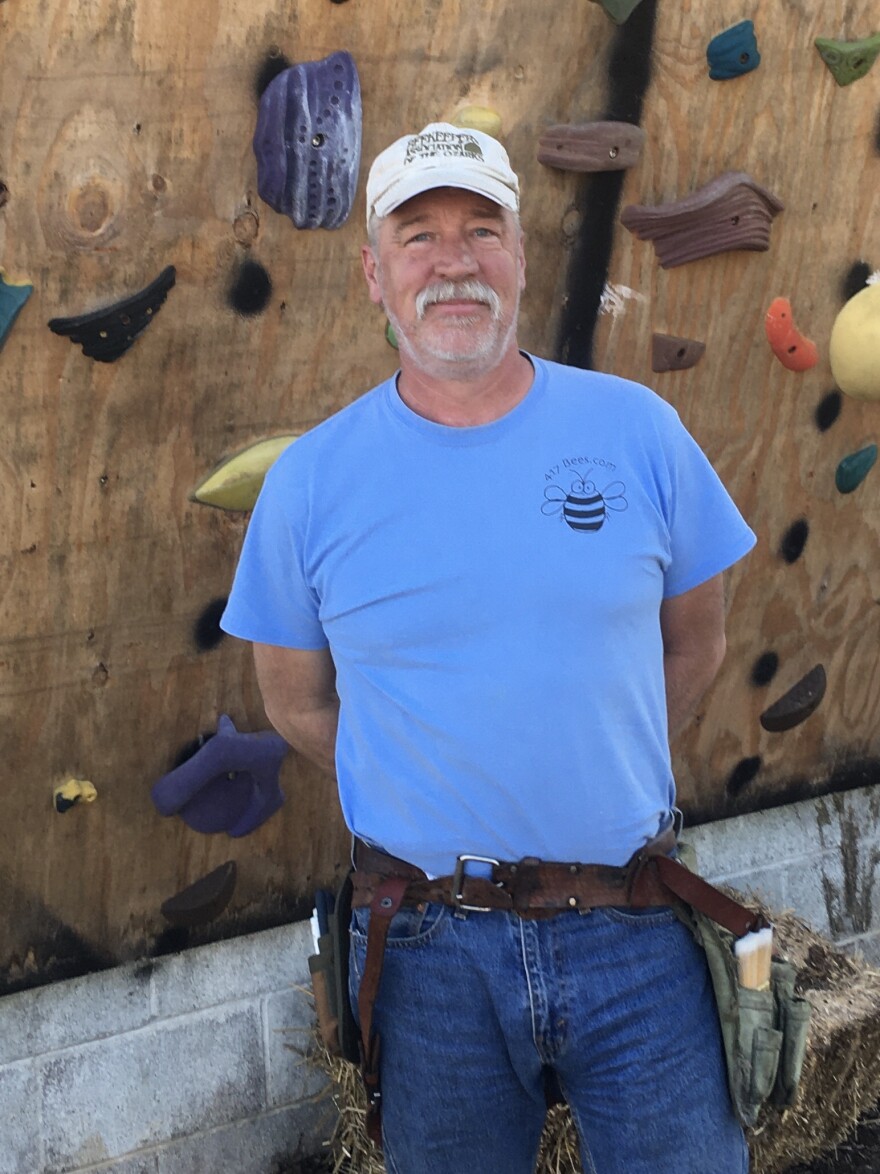"One of the cool things about beekeeping," says Jeff Maddox, "is it's kind of stress reducing. To work in a bee hive, you have to move slowly and smoothly. It's a lot like doing Tai chi. You can't be a quick go at it, get it done kind of person if you're going to be a good beekeeper."
Meet Jeff Maddox, president of the Springfield based Beekeepers Association of the Ozarks. Established in 1974, The group has around 200 members today. As owner and operator of 417-Bees, Jeff Maddox is a professional beekeeper and is what in the business of beekeeping is called a Sideliner.
"A Hobbyist is usually defined as somewhere between two and 10 hives. A Sideliner is usually 50 to maybe 300. When you get over 300, you're called a Commercial Beekeeper." Maddox says.
Jeff Maddox also specializes in nonlethal removal of unwanted bees from natural habitat or manmade structures and relocating those bees to new hives and colonies. His hives are placed in what he calls bee yards, located in and around Rogersville, Springfield and Halltown. On a warm and sunny day earlier this month, I visited with Jeff Maddox at the Urban Roots Farm on State Street here in Springfield, where Jeff Maddox opened up one of the five hives he manages there.

"And all of these beehives came from removals. I've got some from Walls and Nixa, some from walls in Springfield," says Maddox. " If I'm going to get into this beehive and take a look and do an inspection and see how my bees are doing, I have to take the lid off. And then these frames hang in the box like file folders do, and the bees are in between on the surfaces of those frames. So we go in, we look at those frames and we see how our bees are doing. And I want to see what those bees are putting in the cells at this time of year,' he says.
"Is it nectar? Is it pollen or are they baby bees? Is the population is bee hive growing? Is this population of the bee hive looking sick or is everything just hunky dory and I can put them back together and walk away." said Maddox.
"So we start our smoker. And this (puffing)sound is very familiar to beekeepers," said Maddox. "Bees communicate by scent. So what the smoke does, it acts much like a loudspeaker would do to us. It confuses their communication a little bit. So instead of paying attention to this big, hairy monster that's getting in their hive, they go and find their sisters because their communication chain has been broken. So the smoke just kind of encourages them to go find each other. Instead of worrying about me,' says Maddox.

"You open up your hive" said Maddox, "and"..."(smoker puffing sound)
"So I'm going to pull a frame out, and it's covered with bees." Says Jeff Maddox. "These bees look good. Nobody looks sickly, nobody's acting sickly. This bee hive is already bringing in pollen from the early maples that are blooming. The early willows, the early dandelions. They're bringing in pollen, which is a very good sign, because that means they're getting into raising baby bees," he said.
According to the Agricultural Marketing Resource Center at agmrc.org, there are between 115 thousand and 125 thousand beekeepers in the United States. Jeff Maddox says hobbyists make up the majority of membership in the Beekeepers Association of the Ozarks.
"95 percent of the people in our club are hobbyists, beekeepers. Most of them have well under 10 hives, usually two to four," says Maddox.
Jennifer Winslow is a member of the Beekeepers Association of the Ozarks and maintains her hives on acreage just outside of Republic, Missouri. "I currently have two hives," says Winslow. "I started out with two and they seem to have made it through the winter," she says.

Winslow began her beekeeping hobby, first by attending Beekeepers Association Of The Ozarks sponsored classes in January 2020, about the same time the pandemic began.
"Well, I had just finished taking the class offered by the Ozark Beekeepers Association, and that was before the pandemic. So that wasn't affected by the pandemic," says Jennifer Winslow. "but shortly after everything shut down. I didn't have my bees yet. I didn't get my bees until May. But there were also a lot of webinars and seminars. And so I was able to watch some of those webinars and seminars online that I wouldn't have had the opportunity to see otherwise," Winslow said.
"I had some members of the Bee Club come out and show us what things were and what needed to be used and what needed to be thrown away. And, you know, online research, Facebook, websites, textbooks, lots of reading. There's a lot to know about how to be a beekeeper and not knowing a lot of the things can be detrimental to the bees and into your hobby." said Winslow.
From May 2020, when she acquired her first batch of bees till July, when she harvested her first batch of honey. Jennifer Winslow proved to be a quick learner and a highly capable beekeeper.

"Yeah, I think every beekeeper has their own way of doing things," said Winslow. "I've talked to some people who extract honey like every month, you know, they'll do in the spring and they do it in the summer and they do it in the fall. And then throughout the winter they feed the bees, sugar or syrup. I just extracted honey last year, one time in July," she said.
"We got about 13 quart jars full of honey last July. It was really good too." Says Winslow.
Jennifer Winslow would have had even more honey from her first harvest had it not been for the antics of an unwanted visitor.
"We did have a bear visit us this summer and tear apart one of our hives and eat some of the honey, and that was an exciting experience." says Winslow. "I did not witness it. I was going down to look at the hives and walked down and found one of them just in pieces. It was all over the ground. The second one was upside down. I was able to just roll it right side up and it was fine. But the first time the bear had gotten into it and eaten four frames full of brood and honey and just tore the whole thing apart. All ended up well, my queens were still alive and there were still plenty of bees to keep going. So I put everything back together and let them continue doing their thing. But it was definitely a surprise to find," Said Jennifer Winslow.
Meanwhile, back in Springfield on State Street at the Urban Roots Farm, Jeff Maddox has located the queen of the hive he's inspecting.

"This right here, this patch of cap cells, those are brand new babys that are going to hatch," says Maddox. "And there's our queen right there, actually. She's right there. That's the queen. The queen is about 30 percent bigger than the other bees'" he says.
"She's got this big long abdomen that nobody else has." Says Maddox. "And you don't see it, but see right there on top of her thorax? It's got like a bald spot that nobody else has'" he said.

Maddox continues..."The queen is the only female in the hive who produces eggs. In this particular hive right now, beginning of March, they're just starting their population buildup. So right now, there's probably 20, maybe 25,000 bees in here. By the end of May, there will be 40,000 bees in here." said Maddox.
"That queen will be laying about a thousand eggs a day. But she's one bee in a colony of 40,000 bees, and they will have achieved population equilibrium about the middle of May," said Maddox. "So she's laying a thousand eggs a day. A thousand bees are dying a day, and they're at their peak population. That's when they can bring in eight pounds of nectar in a day, drop by drop." Said Maddox.
According to the U.S. Department Of Agriculture, in 2019, 2.81 million U.S. bee colonies produced 157 million pounds of honey. Jeff Maddox says, bees, like many forms of wildlife, reproduce in the spring, but do so in a way which might make a few folks a little nervous.

" And how a bee colony reproduces is, it grows the number of bees until it really crowded inside the bee hive. And then they get too crowded in there like, look, some of you got to move out," says Maddox. "
“So they raise a second queen. And when that second queen is just about ready to hatch, the old queen leaves the hive with about half to 60 percent of those bees,” he says. “And that's what we call a swarm. And that swarm flies out of the hive and they hang on a branch someplace and they send out scouts to find a new cavity to live in. But while they're hanging on that branch, here's this ball of bees that scares the bejeebers out of everybody’” Maddox said.
“That's going to happen in April and May,” says Jeff Maddox. “Around here, I get dozens of swarm calls every year. And the public needs to know that if they see a swarm, call the beekeepers. Don't kill it, don't spray it with flames or a fire extinguisher or something. We have a list on our website, ozarksbeekeepers.org. We have a swarm list right there with a whole list of beekeepers they can call to come pick up that swarm, and will do it for free.” He said.

For the KSMU Sense of community series. I'm Mike Smith.



